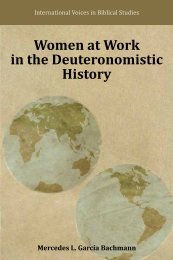Global Hermeneutics? - International Voices in Biblical Studies ...
Global Hermeneutics? - International Voices in Biblical Studies ...
Global Hermeneutics? - International Voices in Biblical Studies ...
Create successful ePaper yourself
Turn your PDF publications into a flip-book with our unique Google optimized e-Paper software.
48 GLOBAL HERMENEUTICS?<br />
be<strong>in</strong>g born and bred on the African cont<strong>in</strong>ent, I also have great appreciation for the<br />
sensitivity of African biblical scholarship to flesh-and-blood contexts (such as<br />
poverty, oppression and the HIV/Aids pandemic) with<strong>in</strong> which the Bible is<br />
<strong>in</strong>terpreted. My identity as a biblical scholar and reader of the Bible is a quilt of<br />
different—sometimes harmonious and sometimes conflict<strong>in</strong>g—dimensions.<br />
My contribution <strong>in</strong> this sem<strong>in</strong>ar stems from this hybrid identity that I am—an<br />
identity that I have come to accept and that I would like to nurture. I therefore also<br />
call on you to <strong>in</strong>terpret my contribution with<strong>in</strong> this condition of hybridity.<br />
REDEFINING “GLOBAL CONTEXT”?<br />
I would like to start my contribution by reflect<strong>in</strong>g on our understand<strong>in</strong>g of “the<br />
global context” that determ<strong>in</strong>es our global hermeneutics. It seems to me that <strong>in</strong> the<br />
literature and <strong>in</strong> our deliberations here “global” is often understood as<br />
“contemporary geography”—an understand<strong>in</strong>g which seeks the locus of our<br />
<strong>in</strong>terpretations exclusively <strong>in</strong> the fact that we live <strong>in</strong> different parts of the world.<br />
Our sem<strong>in</strong>ar session was <strong>in</strong>troduced by a paper explor<strong>in</strong>g the geographical and<br />
<strong>in</strong>stitutional aspects of global Old Testament studies (Holter). The case studies that<br />
followed were presentations from different parts of the world—Africa, Lat<strong>in</strong><br />
America, Asia and Europe—and deliberately so. These perspectives are, of course,<br />
<strong>in</strong>dispensable and valuable for our understand<strong>in</strong>g of and discussions on global<br />
hermeneutics.<br />
However, I am wonder<strong>in</strong>g whether we should not widen our understand<strong>in</strong>g of<br />
“global context” by also <strong>in</strong>clud<strong>in</strong>g a temporal dimension <strong>in</strong> our def<strong>in</strong>itions. 4 Our<br />
understand<strong>in</strong>g of “global” lets us ask the question: how should we <strong>in</strong>terpret the<br />
Bible together with our brothers and sisters all over the world? And rightly so!<br />
However, should we not also <strong>in</strong>clude a temporal perspective which makes us aware<br />
that we are not only <strong>in</strong>terpret<strong>in</strong>g the Bible together with our brothers and sisters,<br />
but that we also do so <strong>in</strong> conversation with our mothers and fathers? Should we not<br />
show greater awareness that all contemporary <strong>in</strong>terpretative communities are<br />
embedded <strong>in</strong> traditions of <strong>in</strong>terpretation?<br />
4 I deliberately avoid the terms “synchrony” and “diachrony” here, because these<br />
notions are often misunderstood with<strong>in</strong> a dichotomy which puts them <strong>in</strong> opposition to, and <strong>in</strong><br />
tension with, one another. See L. C. Jonker, “Read<strong>in</strong>g with one eye closed? Or: What you<br />
miss when you do not read biblical texts multidimensionally,” OTE 19/1 (2006), 58–76. See<br />
also J. Barr, “The Synchronic, the Diachronic and the Historical: A Triangular<br />
Relationship?” <strong>in</strong> Synchronic or Diachronic? A debate on method <strong>in</strong> Old Testament exegesis<br />
(ed. J. C. De Moor; OTS 34; Leiden: Brill), 1–14; D. J. A. Cl<strong>in</strong>es, “Beyond<br />
Synchronic/Diachronic,” <strong>in</strong> Synchronic or Diachronic? A debate on method <strong>in</strong> Old<br />
Testament exegesis (ed. J. C. De Moor; OTS 34; Leiden: Brill), 52–71.




